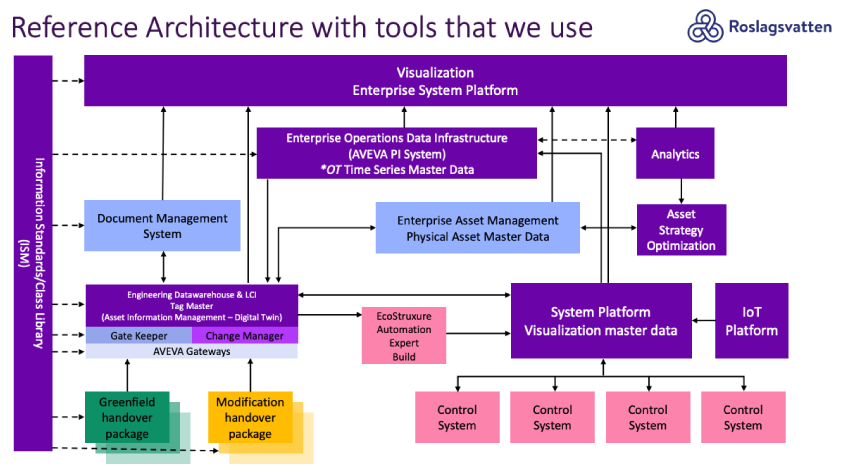Why tackling water scarcity requires a rethink on technology investment
Posted: November 14, 2025

Water supply is one of the most critical pillars of everyday life, a fact that holds true as much for companies as for households. It is also increasingly under pressure.
Yet many water utilities lack real-time awareness or lose a lot of water to leaks.
Six years ago, Sweden's Roslagsvatten exemplified one of the reasons why. The water and wastewater company serves over 130,000 customers in Stockholm but is owned by five municipalities. Each of them had its own methods, tools and systems to deal with the local water supply. This fragmented approach naturally caused lots of inefficiencies—a story well familiar to many water companies around the world.
Our Industrial Life
Get your bi-weekly newsletter sharing fresh perspectives on complicated issues, new technology, and open questions shaping our industrial world.
Efficiency: the elephant in the room
Water is already becoming scarce. Some 25 countries, housing a quarter of the global population, face extremely high water stress every year. Climate change, along with population growth, is only set to make things worse: Many more regions are very likely to start experiencing drought-driven water scarcity by the end of this decade, including across the Mediterranean, southern Africa and parts of North America.
Coping with this growing pressure on water supplies would be challenging even if it weren’t for the water sector’s staggering inefficiency.
Consider this: In the EU, nearly a third of all water collected for public supply is lost before it ever reaches end users. Ireland, for example, loses about 38% of its treated water to leaky pipes.
In the U.S., leaks and pipe failures, as well as administrative errors, inaccurate metering and unbilled consumption, carry a similar toll. They cost utilities some 2.7 trillion gallons of water, or more than $6.4 billion in unrealized revenue, every year.
The point is that a lot of water—and money—is wasted every day due to inefficiency.
This should concern power providers, too. Water utilities need vast amounts of energy to extract their water from lakes and rivers, lift it from aquifers, pump it through pipes and treat and deliver it to customers.
In fact, water utilities are often the biggest energy users in their area. Globally, the water industry uses around 1,000 TWh every year. That’s more than 3% of total electricity demand.
Now, power demand is forecast to rise dramatically in many countries, including from some areas of water management. Electricity use in desalination, for example, is set to more than triple by 2040. Then there’s the rapid rise of data centers, which not only need vast energy supplies but guzzle up a lot of water, too.
All this means there is a clear opportunity for power and water companies to help each other reduce consumption.
How data can be used to ease water scarcity
Here’s the thing: Water companies actually have access to all the tools they need to boost efficiency. We now have methods to pinpoint leaks down to the household level.
But many utilities still treat investments in technology purely as a cost, not an opportunity to improve their business—and the service they provide to consumers. In the public sector, this issue is compounded by low-cost bidding processes, which often mean utilities end up with inefficient processes.
Even when they do invest in technology, many companies have by now amassed multiple tech stacks from different vendors—creating data silos that inhibit access to critical real-time information. Without unified oversight, tackling issues such as energy efficiency, chemical consumption and water leaks becomes much harder.
It also means utilities face self-imposed barriers to adopting potentially game-changing technologies, from digital twins to AI. Without a firm grip on their data, even investments in useful tools like smart water meters won’t do much good.
In light of rising water stress and the wasteful status quo, water companies that want to be a part of the solution should:
- Change their mindset on technology investments,
- Become more targeted in their procurement decisions and
- Make sure their data can, and will, be used in the most effective way.
These steps are necessary if utilities want to future-proof their business. They may sound big, but it’s OK to start small. And there are now some useful blueprints to guide the way.
Take Roslagsvatten, the Swedish water company. In 2019, it set out to overhaul its entire technology stack over a period of five years. The result was a new, simplified, standardized system capturing the company’s entire operational data:

Uniting information about all the company’s assets in one system, and visualizing that information effectively for employees, has unlocked more targeted maintenance and quicker upgrades. That means Roslagsvatten is now more efficient in building new assets and in managing its existing infrastructure—be it a wastewater plant or pumping station.
With rising water stress, utilities must do more to make sure they are using this precious resource responsibly. The good news is the sector already has the tools to cut waste and make a difference. Now it’s time to take the next step.